Partial-Depth Repairs
4.0 Construction
With good design and construction practices partial-depth repair should last as long as the surrounding concrete pavement. The most frequent causes of performance problems are related to misuse of the technique, poor repair material and careless installation.
4.1 Finding Unsound concrete
The first step in constructing a successful partial-depth repair is the identification and removal of all deteriorated concrete. Unsound concrete is commonly located by "sounding out " the delaminated area. Sounding is done by striking the concrete surface with a steel rod or ball-peen hammer, or by dragging a chain along the surface. The rod, hammer, and chain will produce a clear ring when used on sound concrete and a dull response on deteriorated concrete.
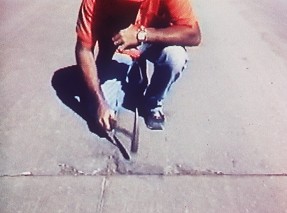 "Sounding" with a ball-peen hammer 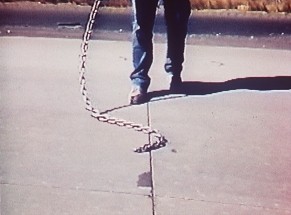 "Sounding" with a steel chain |
4.2 Determine the Repair Boundaries
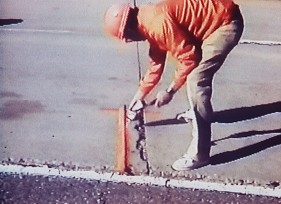 Marking Area for Removal |
Include all deterioration within the repair boundaries. Clearly mark each boundary with brightly-colored spray paint to outline the removal area. To assure the complete removal of all unsounded concrete, use the following guidelines:
- Repair boundaries should be square or rectangular.
- Use a minimum length of 12 in (300 mm).
- Use a minimum width of 4 in (100 mm).
- Extend the repair limits beyond the delamination marks or visible spalls by 3-4 in (75-100 mm).
- Do not repair a spall that is less than 6 in (150 mm) long and less than 1.5 in (35 mm) wide.
- Combine repairs less than 12 in (300 mm) from each other.
- Repair the entire joint length if there are more than two spalls along a transverse joint.
4.3 Removal of Concrete
a. By Sawing and Chipping
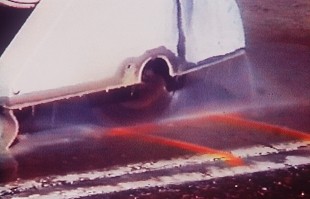 Diamond-bladed saw for the Sawing and Chipping |
When using a method that chips the concrete for removal by hand, saw along the perimeter of the removal area. Use diamond-bladed saws set to a depth of about 1-2 in (25-50 mm). The cut should be straight and vertical. Overrun the cut slightly so that the bottom of the cut intersects the repair corner. Break the concrete using a light pneumatic hammers no heavier than 30 lb (13.5 kg). Lighter, 15 lb (7 kg) hammers are preferable so that it is easier to control the depth of chipping. Spade bits are preferable to gouge bits for control of chipping. Even light hammers with gouge bits can damage sound concrete.
Chip the area until sound and clean concrete along the entire bottom of the repair is exposed. The depth of the repair should not exceed about one-third the pavement thickness. If more chipping is necessary to find sound concrete, or dowel bars are exposed, switch to a full-depth repair.
b. By Carbide Milling
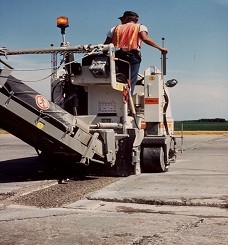 Milling Operation |
Some States have successfully used carbide-tipped milling machines for partial-depth repair. Use a milling machine with a kilowatt rating on the high-end for its class. Milling machines with 12 in to 18 in (300 - 450 mm) wide cutting heads have proven efficient and economical, particularly when used for large area.
The milling machine must have a mechanism that will stop penetration of the milling head at a preset depth. This will prevent excessive removals. Otherwise there is potential danger of damaging dowel bars or reinforcement by milling too deep. Depending on the equipment and the lane closure conditions, the milling machines can operate either across lanes or parallel to the pavement centerline. Milling across lanes is effective for spalling along an entire joint. For smaller, individual spalls, either orientation is effective. The milling head should be checked occasionally for missing teeth. Replace them as needed.
4.4 Cleaning
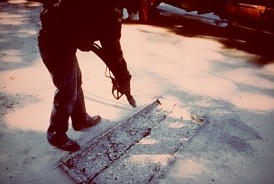 Sand Blasting of Repair Areas 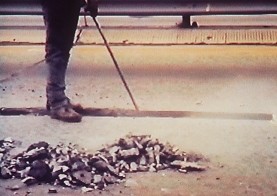 Airblow to Remove Dust and Debris |
After removing the concrete within the delaminated area, check the bottom by sounding for remaining weak spots. Either chip away the weak areas or consider a full-depth repair if the deterioration goes too deep. The exposed faces of concrete should be sandblasted free of loose particles, oil, dust, traces of asphaltic concrete and other contaminants before placing patching materials.
High-pressure water blasting is an alternative to sandblasting where controlling dust is critical in urban environments. Waterblast equipment for concrete removal should be capable of producing a blast pressure of 100-200 MPa. (14,500 - 29,500 psi). However, to avoid damage, the equipment must be capable of adjustments that will allow removal of only weakened concrete.
Airblow the repair area to remove dust and sandblast residue. Direct the debris away from the repair area so that wind and traffic will not carry it back. Dust and dirt prevent the repair material from bonding to the old concrete. The air compressor should deliver air at a minimum of 2.6cy (3.4 M3) per minute and develop 90psi (.63 MPa) nozzle pressure. Even if the equipment has a filter, check the air for oil and moisture contamination. Place a clean cloth over the nozzle and blow air through the cloth. Examine the cloth for any discoloration from moisture or oil residue.
4.5 Placing the Joint Insert
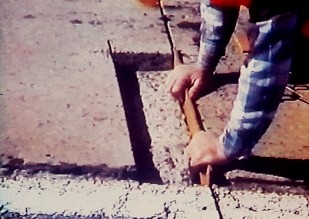 Joint Insert |
Partial-depth repairs that abut working joint or cracks require a compressible insert. The compressible insert reforms the joint or crack and keeps the new repair from bearing on the adjacent concrete. The insert also makes a uniform face that is helpful when resealing the joint or crack. Common compressible insert materials are Styrofoam or asphalt-impregnated fiberboard. The insert should have a scored stop strip and extend 1 in (25 mm) below and 3 in (75 mm) beyond the repair boundaries to prevent the repair material from flowing into the joint. An additional saw cut may be necessary to allow the insert to fit properly.
Without the compressible insert, the repair may fail quickly. Pavement expansion in hot weather will force the adjacent pavement to bear directly against the spall repairs. The is termed "point bearing" and will fail by pop-out or delamination.
4.6 Applying Bonding Agent
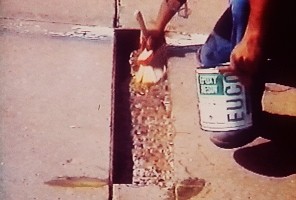 Application of Bonding Agent |
When a bonding agent (cementitious grout) is required, the materials should be applied in a thin even coat. The contact time (it should not dry out ) for cement grout should not exceed about 90 minutes. Check the repair area for any dust or sandblasting residue before placing a bonding agent. The area should be clean and dry. Wiping the area while wearing a dark brown or black cotton glove will easily indicate a dust problem. Airblow again if the dust has settled back in the repair area. Scrubbing the bonding materials in with a stiff-bristled brush works well to get the materials into surface cavities. Epoxy agents may permit a less vigorous application. Be sure to cover the entire area with the bonding agent, including the repair walls or edges. Overlapping the pavement surface also will help promote good bonding.
4.7 Placing the Repair Material
The volume of material required for a partial-depth repair is usually small. Ready-mix trucks and other large equipment may be used if a sufficient number of repair areas are prepared ahead of time and if the working time of the material is sufficient long to allow placement of the entire amount of the material. For partial-depth repair, repair materials are typically mix on site in small mobile drums or paddle mixers.
Place concrete into the repair area from wheelbarrows, buggies, or other mobile batch vehicles. For small repairs, shovel the patch material. Where the repair material is mixed in repair area with the truck's chute, slightly overfill the repair area to compensate for consolidation. ??? Keith
Vibrate the fresh concrete to eliminate any voids, especially at the interface of the repair and existing concrete. Use small spud vibrators with a diameter of less than 1 in (25 mm). Do not drag the vibrator through the mix - this may cause segregation and loss of entrained air. Use small penetrations of the vibrator throughout the repair area. It should be lifted up and down and not moved horizontally. Hold the vibrator about 15° - 30° to vertical. On very small repairs, hand tools should be sufficient to work the repair material and attain adequate consolidation.
4.8 Finishing
Finish the repair surface to meet the elevation of the surrounding pavement. Trowel the patch outward, from the center toward the edges, to push the repair material against the walls of the patch. This technique provides a smooth transition and increases the potential for high bond strength. Most finishers tend to finish a repair from the edges toward the center, which pulls the material away from the edges. For small repairs, and projects that include diamond grinding, texturing is not important. For projects with many repairs, matching the existing surface texture will produce a more uniform appearance.
4.9 Curing
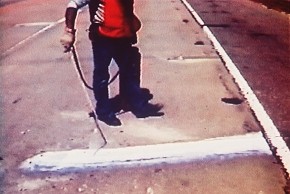 Application of Curing Compound |
For curing, apply a liquid-membrane-forming curing compound evenly and sufficiently. Use well-maintained pressure spraying equipment that will allow an even application. An application rate of about 5.0 M2/L is sufficient. Curing is very important because of the large surface area of these small repairs compared to the small volume of repair material. This relationship is conductive to a rapid moisture loss and is different from most other concrete applications. Neglecting to cure the repairs or waiting too long to apply the compound will likely result in excessive material shrinkage and possibly delamination of the repair.
Where early opening of the pavement to traffic is required, it may be beneficial to place insulation mats over the repairs. This will hold in heat from hydration and promote increased strength gain for cementitious materials.
4.10 Joint Sealing
After the patch has gained sufficient strength, the joint can be resealed. It is important that the joint faces are clean and dry for good sealant performance. Sawing, to provide the proper joint shape factor, and sandblasting, to remove dirt and saw residues from the joint faces, are essential. Resealing the joint is extremely important, because it will help prevent moisture and incompressibles from causing further damage.

